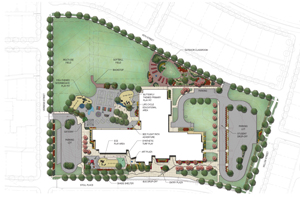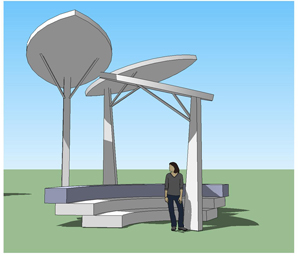The Denver School of Science and Technology’s Conservatory Green Middle School and High Tech Elementary School is the site of a new “learning landscape” that features interactive learning and educational teaching tools integrated throughout the campus.


The shared school, with grades from early childhood education through eighth (ECE-8), is a new Denver Public School located in the Stapleton Conservatory Green neighborhood, a redevelopment community situated on the site of the former Stapleton International Airport.
Lafayette, Colo.-based community and landscape architecture firm Design Concepts CLA Inc. was hired by RB+B Architects, Fort Collins, Colo., the project architect, to design the site. The landscape contractor was Designscapes Colorado Inc., Centennial, and the schools were built by Roche Constructors Inc. of Greeley.
From active play to passive and reflective areas, the learning landscape theme combines “colors, patterns and textures of animals, insects and patterns found in nature,” said Carol Henry, president and principal landscape architect of Design Concepts. “Special design features include integrating fun and colorful educational symbolism.”
Those features include a butterfly lifecycle walkway, a U.S. map painted on asphalt, nature-themed play equipment with dragonfly-like patterns, abstract insect forms embedded into play pits, the flight path of a bee integrated into an outdoor adventure area, and Quick Response Codes etched into a maze to create an integrated-learning component.
Animal and nature themes are also interwoven throughout the site. A discovery area is themed around plant life and includes an outdoor classroom with a tactile discovery walk. Custom shade structures were created to resemble giant leaves.
At the main entry plaza, etched water patterns provide a visual progression typically found in a watershed. The student garden area contains native materials and plantings. A buff sandstone amphitheater sits under leaf cutouts in the shade structures, an oversized cottonwood stump creates a picnic table and seats, a wooden bridge crosses a cobbled-stream channel, stone patterns are imbedded
in the crushed gravel walkways and a path of tree stumps forms an adventure “balance” walk.
The landscape design also includes amenities more typical for a school site, including outdoor recreation and play fields and open spaces and plazas to embrace the community, along with carefully planned parking and student drop-off and pick-up zones for both parents and buses.
“The design not only provides maximum functional site organization and amenities but also offers a fun and healthy active learning environment for students, teachers, parents and the surrounding community,” Henry said.

Post a comment to this article
Report Abusive Comment